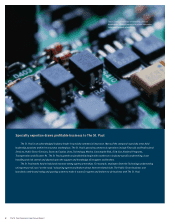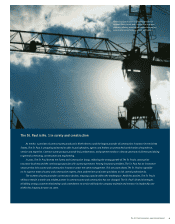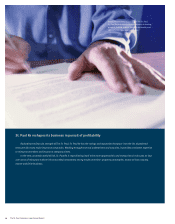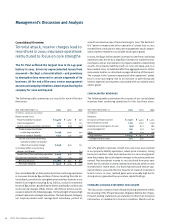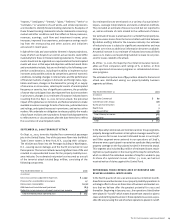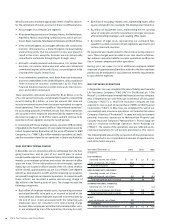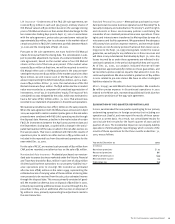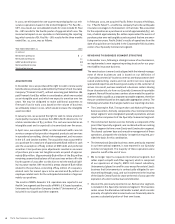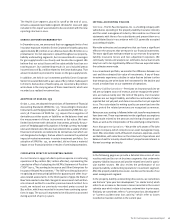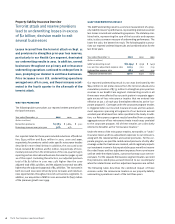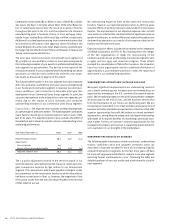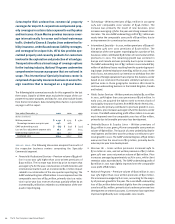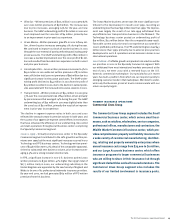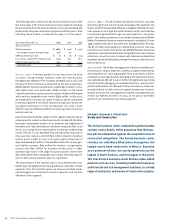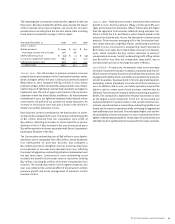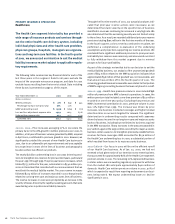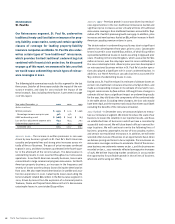Travelers 2001 Annual Report Download - page 20
Download and view the complete annual report
Please find page 20 of the 2001 Travelers annual report below. You can navigate through the pages in the report by either clicking on the pages listed below, or by using the keyword search tool below to find specific information within the annual report.
Property-liability Insurance Overview
Terrorist attack and reserve provisions
lead to underwriting losses in excess
of $2 billion; decision made to exit
several businesses
Losses incurred from the terrorist attack on Sept. 11
and provisions to strengthen prior-year loss reserves,
particularly in our Health Care segment, dominated
our underwriting results in 2001. In addition, several
businesses throughout our primary and reinsurance
underwriting operations continued to underperform in
2001, prompting our decision to exit those businesses.
Price increases in our U.S. underwriting operations
averaged over 16% in 2001, and those increases accel-
erated in the fourth quarter in the aftermath of the
terrorist attack.
written premiums
The following table summarizes our reported written premiums for
the last three years.
Year ended December 31 2001 2000 1999
(Dollars in millions)
Net written premiums $ 7,763 $ 5,884 $ 5,112
Percentage increase over prior year 32% 15%
Our reported totals for these years included reductions of $128 mil-
lion, $474 million and $273 million in 2001, 2000 and 1999,
respectively, for premiums ceded under specific reinsurance treaties
described in more detail below. In addition, the 2001 and 2000
totals included $71 million and $7 million, respectively, of incre-
mental premiums from the elimination of the one-quarter lag in
reporting certain international business discussed on pages 15 and
16 of this report. Excluding these factors, our adjusted premium
total of $7.82 billion in 2001 was 23% higher than the 2000
adjusted total of $6.35 billion, and the adjusted 2000 total was 18%
higher than the adjusted 1999 total of $5.38 billion. The increases in
both 2001 and 2000 were driven by price increases and new busi-
ness opportunities throughout most of our business segments. In
addition, our acquisition of MMI in 2000 accounted for $197 million
of the premium growth over 1999.
gaap underwriting result
The GAAP underwriting result is a common measurement of a prop-
erty-liability insurer’s performance, representing premiums earned
less losses incurred and underwriting expenses. The statutory com-
bined ratio, representing the sum of the loss ratio and expense
ratio, is also a common measure of underwriting performance. The
lower the ratio, the better the result. The following table summa-
rizes our reported underwriting results and combined ratios for the
last three years.
Year ended December 31 2001 2000 1999
(Dollars in millions)
GAAP underwriting result $(2,294) $ (309) $ (425)
Loss and loss adjustment expense ratio 102.5 70.0 72.9
Underwriting expense ratio 28.1 34.8 35.0
Statutory combined ratio 130.6 104.8 107.9
Our reported underwriting result in 2001 was dominated by the
$941 million in net pretax losses from the terrorist attack and a
cumulative provision of $735 million to strengthen prior-year loss
reserves in our Health Care segment. Underwriting results in all
three years were affected by our participation in separate aggre-
gate excess-of-loss reinsurance treaties that we entered into
effective on Jan. 1 of each year (hereinafter referred to as the “cor-
porate program”). Coverage under the corporate program treaties
is triggered when our incurred insurance losses and loss adjust-
ment expenses spanning all segments of our business exceed
accident year attachment loss ratios specified in the treaty. In addi-
tion, our Reinsurance segment results benefited from a separate
aggregate excess-of-loss reinsurance treaty in each year, unrelated
to the corporate program. All of these treaties are collectively
referred to hereafter as the “reinsurance treaties.”
Under the terms of the reinsurance treaties, we transfer, or “cede,”
insurance losses and loss adjustment expenses to our reinsurers,
along with the related written and earned premiums. For the cor-
porate program, we paid the ceded earned premiums shortly after
coverage under the treaties was invoked, which negatively impacts
our investment income in future periods because we will not recover
the ceded losses and loss adjustment expenses from our reinsurer
until we settle the related claims, a process that may occur over sev-
eral years. For the separate Reinsurance segment treaties, we remit
the premiums ceded (plus accrued interest) to our counterparty
when the related losses and loss adjustment expenses are settled.
The following table describes the combined impact of these
cessions under the reinsurance treaties on our property-liability
underwriting operations in each of the last three years.
The St. Paul Companies 2001 Annual Report18


